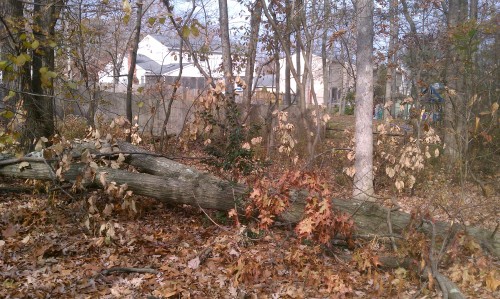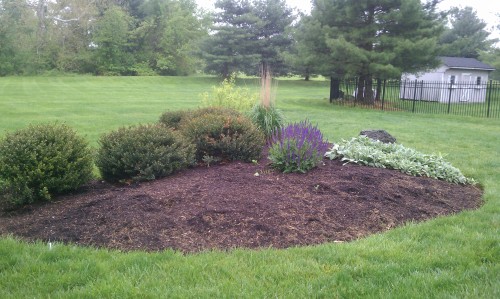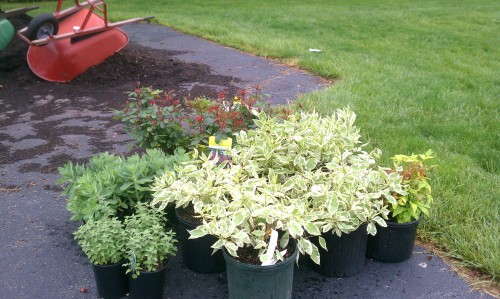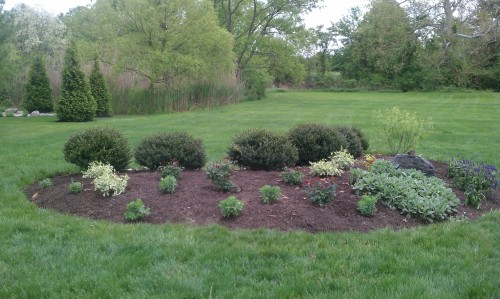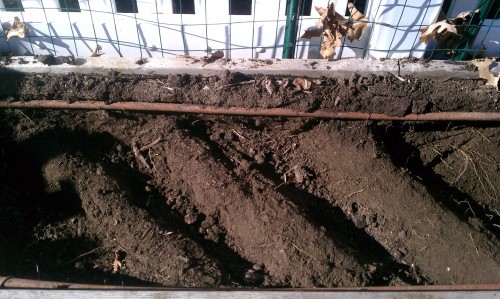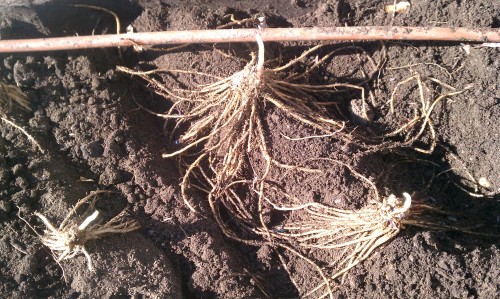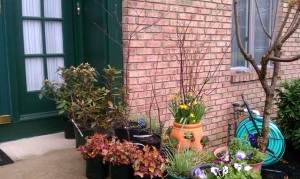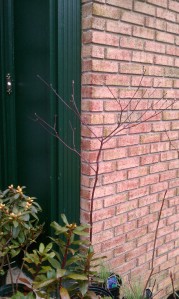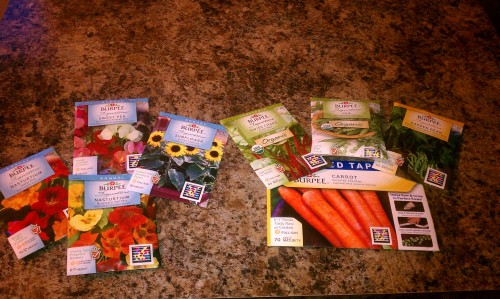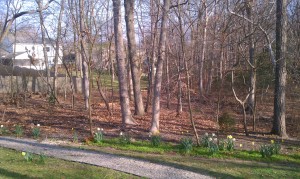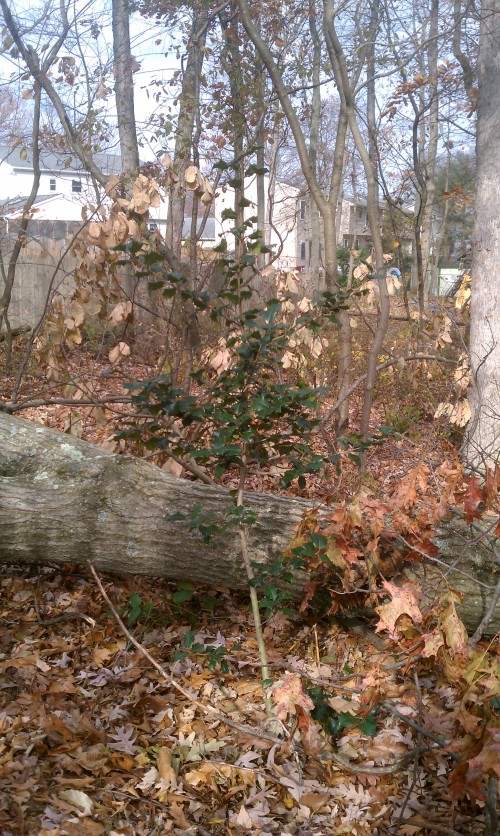 When a fifty-foot oak in our woods fell victim to Hurricane Sandy a few weeks ago, my first thought was, “thank goodness it missed the house.” My second thought was for the lovely little Dan Fenton holly tree that I planted about four years back. She has grown steadily in stature and beauty, providing cover for the local songbirds and a lovely sight from my kitchen window. I thought for sure the fallen oak had taken her square out. And what a loss it would be, since hollies grow so very slowly and who knows when I could replace her. But most happily, the oak missed my little holly by a mere six inches or so. I’m thrilled for my little survivor – a reminder of the survivor in all of us – and send love, prayers and support to the many thousands of people still coping with the aftermath of an unimaginable natural disaster.
When a fifty-foot oak in our woods fell victim to Hurricane Sandy a few weeks ago, my first thought was, “thank goodness it missed the house.” My second thought was for the lovely little Dan Fenton holly tree that I planted about four years back. She has grown steadily in stature and beauty, providing cover for the local songbirds and a lovely sight from my kitchen window. I thought for sure the fallen oak had taken her square out. And what a loss it would be, since hollies grow so very slowly and who knows when I could replace her. But most happily, the oak missed my little holly by a mere six inches or so. I’m thrilled for my little survivor – a reminder of the survivor in all of us – and send love, prayers and support to the many thousands of people still coping with the aftermath of an unimaginable natural disaster.
Posted in Natives | 1 Comment »
I loved last year’s Winter Container Garden class at Longwood so much that I decided to give a similar class this year as a contribution to the UUCCH auction. We had a gorgeous, sunny afternoon for planting. It’s hard to believe a hurricane came through the mid-Atlantic just a few weeks ago, but one benefit is that I collected dozens of fallen pine and birch branches to decorate the containers. We did fine-textured evergreens (arbor vitae and variegated dwarf false cypress) with lovely red-tinged nandina domestica. In fact, the nandina were so large that we ended up splitting them in half to use two per container. For accents, I cut holly, beauty berry and magnolia stems from the UUCCH grounds. My friend Mia brought along some holly from her yard, and some wonderful rhododendron as well. In fact, we had so many cut branches that I ended up using them to accent my planting beds and other containers as well. All the guests added their own unique touches to the containers, and I have to say, the results were lovely. All told, a successful class and supremely pleasant afternoon.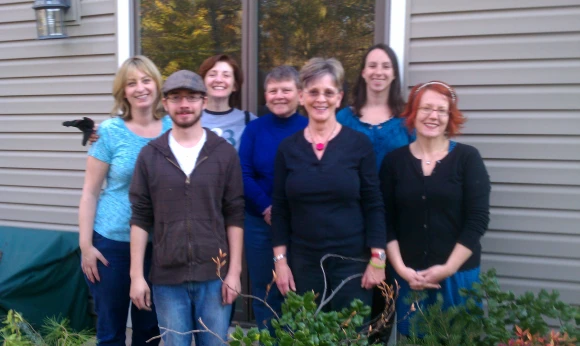
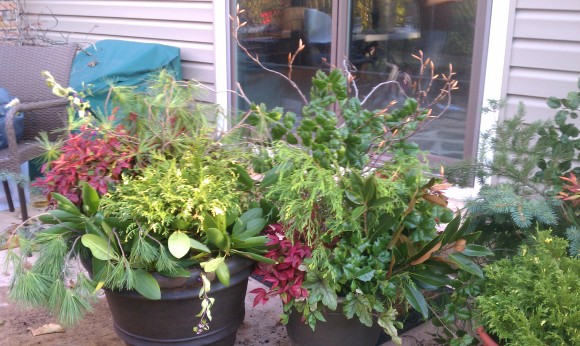
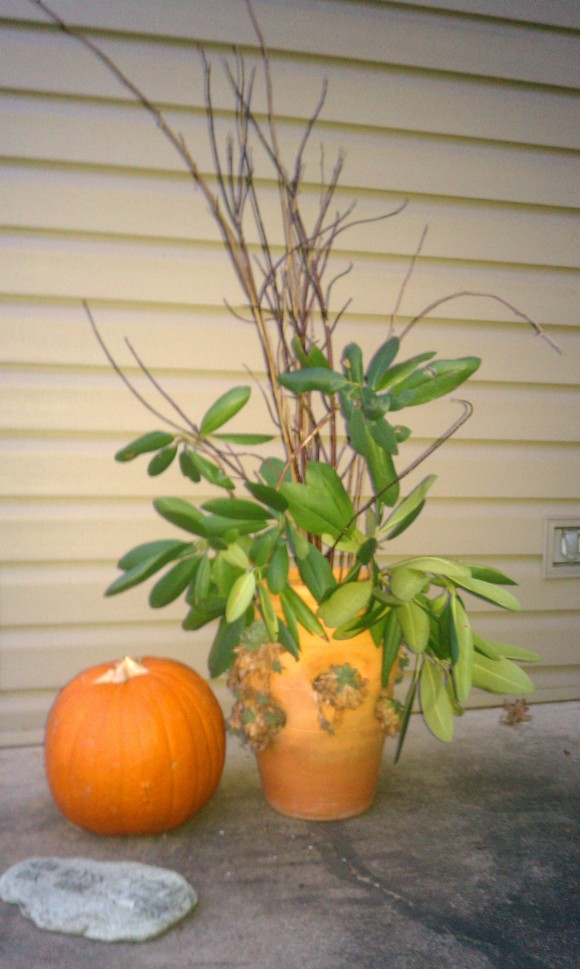
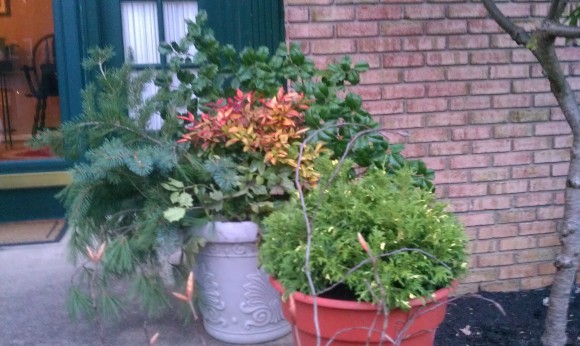
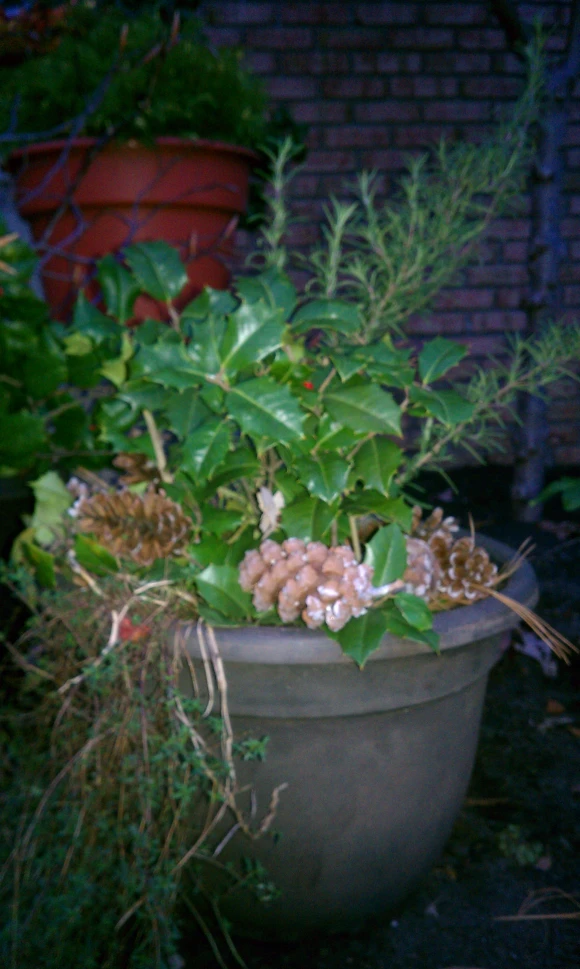
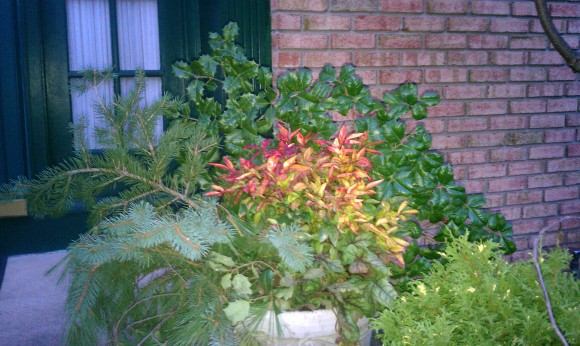
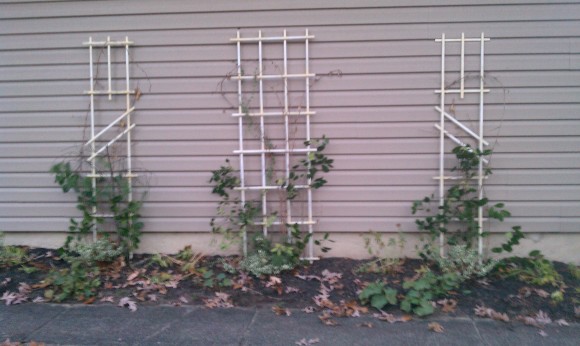
Posted in Garden Design | Leave a Comment »
As I worked on the new island bed for my sister-in-law, I began thinking about the types of plants that are best suited for gardens here in the Mid-Atlantic area. To make a garden visually interesting, it’s important to incorporate a variety of plant heights, shapes and textures. A combination of small accent trees, shrubs, bulbs and perennials usually does the job. Once established, these kinds of mixed gardens require little maintenance.
It’s also useful to use elements that are attractive at different times of the year. Like all of us, our gardens need to work hard during every season! And although some gardeners have the advantage of plentiful sun, many do not. So I considered plants that can work in a variety of light conditions. And of course, I have a strong preference for East Coast natives that support local wildlife.
With all of these ideas in mind, I came up with this ‘top ten’ list for Mid-Atlantic gardens:
1. Flowering Dogwood (cornus florida): Nothing announces Spring better than the beautiful flowering dogwood. Native to the Eastern US, it is lovely as a small accent or understory tree at the woodland’s edge. And once the leaves have fallen, the graceful branch structure offers interest all winter.
2. Shadbush (amelanchier): Another North American native, Shadbush is a graceful small tree for sunny or partly shady areas. Some varieties grow as multi-stemmed large shrubs. They offer spring flowers, beautiful fall color and edible blueberry-like fruits. I recently planted a trio of the ‘Princess Diana’ variety at the edge of my yard, and they are already growing in nicely.
3. Inkberry Holly (ilex glabra): Every garden needs evergreens for structure and year-round color. Inkberry holly is my go-to evergreen for a number of reasons. First, as a native plant, it supports the local habitat. Second, it grows happily in sun or shade. Finally, inkberry serves as a reliable backdrop to more showy small shrubs and perennials in the garden.
4. Redtwig Dogwood (cornus sericea): Talk about a four-season plant! The dogwoods in my garden have graceful variegated leaves in spring, soft white flowers in early summer, and showy deep red stems in fall and winter. I love to cut branches for holiday decorations. Beyond adding structure and interest to the garden, redtwigs are also a native plant.
5. Knockout Rose (Rosa ‘knockout’): OK, so everybody plants them. But for good reason – they’re the easy to grow, resistant to pests, require no maintenance, and offer beautiful color from spring until fall. I use red knockouts in my back yard, soft pink to border the vegetable garden, and sunny yellow at the beach. If you’re new to roses or have been afraid to try them, Knock-outs are truly a great option.
6. Virginia Sweetspire (itea virginica): Another wonderful, easy-care native shrub, Sweetspire offers white bottle-brush flowers in the spring, glossy green leaves all sumer, and blazing fall color. I like ‘Henry’s Garnet’ for large gardens and ‘Little Henry’ for smaller areas. I planted Little Henry in my stream-side border, where it does just fine in partial shade.
7. Grecian Windflower (anemone blanda): I’ve just about given up on bulbs. Squirrels dig up the tulips. Daffodils are lovely in bloom, but then leave ugly foliage behind. Grecian windflower, however, may just change my mind. This graceful plant is among the first to emerge in the spring. It offers fern-like foliage and long-lasting small flowers of white and purple. Plant a few in partly shady areas, and they’ll grow in drifts. And by the time they start to fade, other perennials will have begun to take over.
8. Switchgrass (panicum virgatum): Ornamental grasses add vertical interest and movement to the garden. Many exotic varieties though, are invasive. These days, I’m ripping out the zebra grass and other exotics, and replacing them with native switchgrass. Numerous varieties offer a range of color choices and heights. At the beach, I’m using the bluish ‘Heavy Metal.’ At home, I’ve just purchased ‘Shenandoah,’ a red-tinged variety, to plant alongside my red knockouts.
9. ‘Autumn Joy’ Sedum (sedum ‘autumn joy’): In the ‘plant it and forget it’ category, sedums take first prize. In fact, they seem to actually thrive on neglect. But these hard-working plants offer wonderful shape and texture in sunny gardens. I like ‘Autumn Joy’ for its long-lasting, rust-colored flowers in late summer and fall.
10. Purple Catmint (nepeta-x-faasseni ‘walker’s low’): Catmint is a reliable perennial with a mounded shape that helps blend taller shrubs and upright plants together in a mixed garden. Its purple flowers attract helpful pollinators. I use the ‘Walker’s Low’ variety and it comes back stronger and bigger every year.
What is your top-10 list for local gardens? I’d love to hear!
Posted in Garden Design | 3 Comments »
My first commission! Ok, a labor of love – but still a first opportunity to design a garden for someone besides myself! My sister-in-law, Lisa, asked me to plant the large, crescent-shaped bed at the end of her driveway. I was excited by the challenge of designing a bed for full sun (since my own yard is mainly shade), and especially such a large space – about 20 feet long by 10 feet at the widest spot. The bed contained a rag-tag assortment of plants – a half dozen globe-shaped evergreens, a leggy willow, a few Russian sage, a clump of Pampas grass, and a large patch of silvery Lambs’ Ear surrounding a large boulder. Lisa’s requirements were simple: No maintenance. Save the purple sage. Oh, and don’t remove the Lambs’ Ear.
Here’s my starting point:
The evergreens pose a bit of a design challenge in my opinion because they are so dense and heavy. After a bit of planning, though, I came up with a design for year-round interest, based on bold color scheme of red, purple and white. I purchased from the nursery:
- 5 ‘Ivory Halo’ red-twig dogwood
- 5 red Knock-Out roses
- 6 ‘Autumn Joy’ sedum
- 3 purple catmint
Also on the shopping list is a ‘Snow Fountain’ weeping cherry – but I have to borrow a truck in order to pick it up. And from my own yard, I added a Nandina Domestica left over from one of my winter containers. Here are the raw materials for the new bed:
With Saturday’s cool and cloudy weather, conditions were ideal for renovating the bed. First, I removed, split and relocated the Pampas grass (not a favorite of mine anyway, so I was glad to see it go! Upon closer look, I discovered that the evergreens were not boxwood, but in fact Japanese holly (much nicer and easier to keep, in my book). I moved a few of the Lambs’ Ear from their dense patch, to line the outside edge of the hollies. The willow got a bit of a haircut.
Then, finally, to add the new plants. I put the Nandina behind the bolder – it will grow tall and develop a lovely red color and bright berries, and the boulder will hide its legs. I surrounded the Nandina with three of the dogwoods, and then split up the sage and added them in along the edge. On the other side of the boulder, I planted the Knock-Outs in a staggered pattern, and edged them with the sedum. The two remaining dogwoods went in on the other side of the roses, bordered by the catmint. Here is the newly replanted bed:
I am very pleased with the result. The dogwoods and Nandina add grace, movement and openness to the bed, while the red Knock-Out roses will offer vibrant color all summer long. The weeping cherry tree will be planted in the empty space next to the willow. Its cascading branches will counteract the upright forms of the willow, dogwoods and roses. The cherry tree has beautiful white flowers in the spring, which will soften the bare twigs of the willow. In the fall, its leaves will have a beautiful orange-red color, complementing the red dogwood stems and sedum flowers. In short, a once-bare bed will offer no-maintenance beauty in every season. Now that’s a labor of love!
Posted in Garden Design | Tagged Knock-out rose, red-twig dogwood, weeping cherry tree | 3 Comments »
Still loving my All-Clad slow cooker and the great collection of slow cooker recipes from the Williams-Sonoma blog.
This past weekend, I made the last of the winter recipes – Stout-braised short ribs. Served over gemelli pasta with butter and grated cheese. Outrageous! The recipe is located here: http://www.williams-sonoma.com/recipe/stout-braised-short-ribs.html.
A new article from Williams-Sonoma highlights the slow cooker’s versatility for preparing lighter, spring recipes – combining traditional spring meats such as lamb, with fresh seasonable vegetables. See the full article here: http://blog.williams-sonoma.com/slow-cooking-for-spring/ I haven’t yet tried cooking fish in the slow cooker, but the salmon recipe looks quite simple – and tasty. Definitely one to try!
Posted in This & That | Leave a Comment »
Today continues the vegetable garden evolution. I planted the beautiful Jersey Prince asparagus from that arrived this week from White Flower farm. Thanks to Margaret Roach for this informative article on asparagus planting techniques. Fortunately, the beds were easy to prepare because I had previously added dried manure to the soil. Since the beds are so narrow, I did place the asparagus crowns closer together than usual. I planted just under 20 crowns altogether, filling up the right bed completely. As the plants grow in, I’ll finish filling in the trenches with the remaining soil. Then, I’ll get to enjoy the lovely plants in the garden for a few years before I can begin to harvest the spears.
Posted in Vegetables | Tagged asparagus | 1 Comment »
Plant lovers: if you live in or travel to the Delaware Valley, make it a point to visit RareFind Nursery . I was first introduced to RareFind by Ken Arnold, the retired landscaper who now tends the beautiful grounds at the Unitarian Universalist Church in Cherry Hill, NJ. RareFind carries plants, shrubs and trees that you simply won’t find anywhere else. Located in Jackson, NJ (close to 6 Flags and outlet shopping), the nursery is situated in the Jersey pines, an ideal location for the rhododendrons, azaleas and other natives that love our acid, sandy soil. In particular, RareFind offers an amazing selection of the native, deciduous azaleas that are much sweeter and lovelier that the garish Asian variety so commonly seen in gardens. Wander through the lush display gardens and then settle in for some serious plant shopping.
Yesterday was perhaps my third or fourth trip to RareFind. My goal was to select trees and shrubs for my Woodland Border restoration project. Following Ann Lovejoy’s ‘Golden Bowl’ approach, I selected ‘Princess Diana’ amelanchier grandiflora trees for the large understory, and some Rhododendron minus v. carolianus shrubs for the small understory. (I’m going to underplant the rhododendrons with a few Coast Leucothoe that I picked up locally last week). I also selected a beautiful Cornus Alternifolia (Pagoda Dogwood) to anchor the streamside border. Even as a young tree, the dogwood has gorgeous, purplish bark and a graceful sympodial branch structure. Finally, I picked up a few perennials including Sedum Ternatum (which, coincidentally is recommended by Mount Cuba Center in my moss gardening course).
All in all, a successful plant excursion. My trip was cut short by rain – otherwise I would certainly have spend much more time, and money! Not to worry though, I’m sure I’ll be back.
Posted in This & That | Leave a Comment »
Finally time to sow early spring vegetables! After a few unsatisfactory growing seasons, I’m planning some major changes this year for the vegetable garden. First, I’m turning the right section into a perennial asparagus bed. This part of the garden gets the most sun, so I think the asparagus will do well. Plus, the plants themselves are so beautiful, I’ll enjoy them during the TWO YEARS that I’ll need to wait for the root systems to mature. Just yesterday, I received word from White Flower Farm that my order of Jersey Knight asparagus crowns is on its way to me. I’ll be able to get them planted before my UK trip.
Beyond the asparagus, I’m focusing on early season vegetables – peas, bush beans, carrots. I’m headed out to plant these today. I’m also sowing leafy greens – Swiss chard and lettuces – as well as their floral companions, marigolds and nasturtiums. So far I haven’t had a chance to order any other leafy greens, but I do want to try mache again and a few different lettuce varieties. My sister-in-law also asked for kale. Later on in the summer I’ll add the cucumbers and squash. The other traditional summer vegetables – tomatoes, peppers – are going in a grow box on the front lawn where they will get more sun and hopefully produce better yields.
Fingers crossed for a beautiful and bountiful harvest!
Posted in Vegetables | Tagged carrots, flowers, green beens, peas, vegetable gardening | Leave a Comment »
 Ann Lovejoy’s Organic Garden Design School by Ann Lovejoy
Ann Lovejoy’s Organic Garden Design School by Ann Lovejoy
My rating: 4 of 5 stars
Ann Lovejoy’s Organic Garden Design School has helped me form a design to restore the woodland gardens that were stripped earlier this year by overzealous tree trimmers. Her ‘Golden Bowl’ analogy enabled me to understand the concept of tree canopy, high understory, low understory and perennials. Previously, I had been focusing just upon low understory shrubs and perennials; now I understand that adding some medium sized trees will help create a more gentle transition from woodland to garden border. Her ‘rule of thirds’ (one third evergreens, one third structural shrubs and one third perennials) also provides a useful guideline for garden design. I will start applying these ideas right away – both to plan out my plant purchases and to site them appropriately.
The only criticism I would have of the book is that some of her recommended plants are considered invasive in this area. Fortunately, I’ve got a good list of native alternatives from my studies at Longwood Gardens. Overall, Ann Lovejoy’s Organic Garden Design is a tremendously useful guidebook. I borrowed it from the local library – and now I’m going to buy my own copy!
Posted in Bookshelf | Tagged garden design, woodlands | 2 Comments »
About two months ago, I made the mistake of allowing a tree service company do some work in my Woodland Border. The workmen were supposed to trim low-lying branches, remove a few dead trees and clear away rotted logs. I think they were really just looking for firewood to sell, because they were overzealous in their trimming. None of the live trees were really harmed, thank goodness, even though the workmen trimmed more than I wanted. The real problem is that they dragged all the cut logs through the planted border and across my yard. As a result, my once-beautiful woodland border is now completely TRAMPLED UNDERFOOT!
What a mess! Now there’s major cleanup and repair work to do. I’ll look on the bright side here however. In my day job as a marketing professional, I use the term ‘compelling event’ to describe an issue that prompts a client to move forward at any given point. Here, I’m using the cleanup as my ‘compelling event,’ to achieve two outcomes:
–Increase the scale and impact of the woodland border, with major additions of native shrubs and plants
–Create an even more beautiful setting for my Summer Garden Party in early June
With these goals in mind, I’m heading to Rare Find Nursery on Saturday to pick up a large order of native shrubs. Here goes the next project!
Posted in Garden Design | Tagged trees, woods | Leave a Comment »
